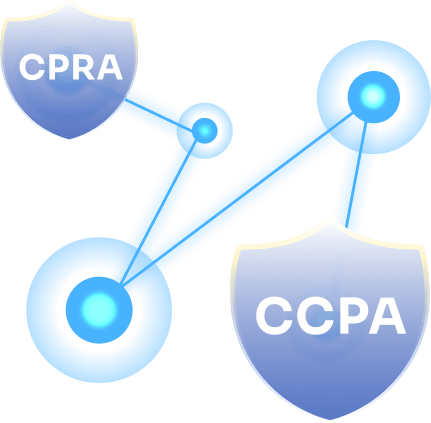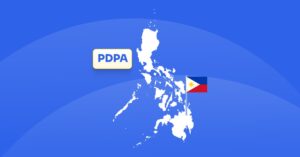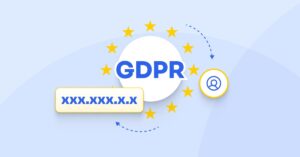Introduction
Data privacy regulations, such as the California Consumer Privacy Act (CCPA) and its successor, the California Privacy Rights Act (CPRA), present significant challenges for businesses. To successfully navigate this complex regulatory landscape, mastering data mapping is essential. In this concise guide, we will explore the role of data mapping in achieving CCPA and CPRA compliance and the tools and techniques available to businesses.
An overview of CCPA and CPRA
The CCPA, enacted in 2018, was a pioneering piece of legislation designed to protect the personal information of California consumers. Its successor, the CPRA, passed in 2020, builds upon the CCPA’s foundation to further enhance privacy rights and protections. The CPRA came into effect on January 1, 2023, and significantly expanded the scope and requirements of its predecessor.
Key requirements of CCPA and CPRA
Both the CCPA and CPRA grant California consumers extensive rights over their personal information, including the right to know what data is collected, the right to access that data, the right to delete it, and the right to opt-out of its sale. They also place various obligations on businesses, such as implementing reasonable security procedures and ensuring consumer data is protected from data breaches.
To comply with CCPA and CPRA, businesses must have a clear understanding of the data they collect, process, and share. Data mapping plays a pivotal role in achieving this understanding, allowing organizations to create a visual representation of their data flows and processing activities.
Defining data mapping
Data mapping is the process of systematically documenting the flow of data within an organization. It involves identifying the sources of data, the types of data collected, the purposes for which it is used, and the parties with whom it is shared.
The role of data mapping in data privacy regulations
Data mapping is the backbone of CCPA and CPRA compliance. It provides the necessary foundation for organizations to meet their regulatory obligations. By creating a comprehensive data map, businesses can clearly demonstrate their data practices, making it easier to respond to consumer requests, maintain security procedures, and prevent data breaches.

The data mapping process: Manual vs. automated
Data mapping is an essential process that helps organizations understand and connect their data assets. It involves identifying the relationships between different data elements and mapping them to a common standard. This standardization allows for better data management, improved decision-making, and enhanced data quality. Traditionally, data mapping has been a manual process, but with advances in technology, automated solutions have become increasingly popular. In this article, we will explore the differences between manual and automated data mapping processes, and the benefits and drawbacks of each.
Manual data mapping: Pros and cons
Manual data mapping involves individuals within an organization documenting data flows, processing activities, and the relevant parties through a labor-intensive and time-consuming process. This method is often error-prone due to its reliance on human input and may not be suitable for organizations with large volumes of data.
Automated data mapping: Pros and cons
Automated data mapping, on the other hand, relies on specialized software to capture and document data flows. It is more efficient and less error-prone, making it the preferred choice for organizations with significant data complexity. Automated data mapping tools can help streamline compliance efforts and ensure the accuracy of the data map.
Combining manual and automated data mapping for optimal results
Many organizations choose to combine manual and automated data mapping for the best results. Manual mapping can help define and verify data flows, while automation ensures the accuracy and consistency of the data map. This hybrid approach maximizes efficiency while minimizing errors.
The importance of identifying personal information
Personal information is all around us. From online shopping to social media, we constantly share and provide personal information in various forms. However, this information can be sensitive and valuable, which is why it’s crucial to understand the importance of identifying personal information. Whether it’s for personal safety or protecting our privacy, recognizing what personal information is and how it can be used is essential in today’s world.
The wide spectrum of personal information
CCPA and CPRA define personal information broadly, encompassing data that can reasonably identify a consumer. This includes traditional identifiers like names and addresses but also extends to less obvious information, such as device IDs and online identifiers.
Categories of personal information defined by CCPA/CPRA
The legislation outlines specific categories of personal information, such as biometric data, geolocation information, and employment-related information. Identifying these categories in your data map is crucial for ensuring compliance.
Mapping sensitive personal information
Sensitive personal information, including data such as social security numbers, financial account information, and consumer’s genetic data, requires heightened protection under CCPA and CPRA. Data mapping should clearly mark these categories to apply the necessary safeguards.
Mapping data flows and processing activities
Mapping data flows and processing activities are crucial components of data management and analysis. The process of mapping data flows involves tracing the path of data as it moves through a system, identifying its sources and destinations, and analyzing its behavior along the way. Processing activities, on the other hand, refer to the various operations that are performed on data as it moves through these flows, including cleaning, transforming, and aggregating the data. By understanding these processes and the tools and technologies used to implement them, organizations can gain valuable insights from their data and make more informed business decisions.
Charting data flows in your organization: A comprehensive data map should include all data flows within your organization. This entails identifying data sources, data destinations, and the routes data takes as it moves through your systems.
Documenting data processing activities: In addition to data flows, organizations must document the processing activities associated with personal information. This includes how data is collected, stored, used, and shared, providing a clear picture of your data practices.

Handling consumer requests under CCPA/CPRA
Consumers have the right to access their personal information, request its deletion, and opt-out of its sale. An effective data map is essential for efficiently responding to these requests within the required timeframes.
Leveraging data maps to fulfill consumer requests
Data maps facilitate the location and retrieval of personal information, ensuring businesses can fulfill consumer requests promptly. Compliance hinges on an organization’s ability to respond to these requests effectively.
Maintaining reasonable security procedures in data mapping
CCPA and CPRA mandate the implementation of reasonable security procedures to safeguard personal information. A data map is an invaluable tool for understanding where vulnerabilities may exist and ensuring appropriate security measures are in place.
Preventing data breaches through data mapping
Data breaches not only expose consumers’ personal information but also result in significant financial and reputational damage to businesses. Preventing breaches is a critical component of regulatory compliance.
An effective data map can help identify potential weak points in your data handling processes, allowing you to implement security measures proactively. Regularly monitoring and updating your data map can mitigate the risk of breaches.
In the unfortunate event of a data breach, your data map serves as a valuable resource for identifying the extent of the breach, the affected data, and the affected individuals. This information is crucial for compliance reporting and timely notification to affected consumers.
Selling and sharing consumers’ personal information
CCPA and CPRA place specific restrictions on the sale of personal information, requiring businesses to honor consumers’ opt-out preferences. The sale of data must be accurately tracked in the data map to comply with these regulations. Sharing data with third parties also falls under regulatory scrutiny. Data mapping should account for all data-sharing activities, detailing the parties involved and the purposes for which data is shared. To ensure compliance, organizations must accurately map the sale and sharing of personal information. This includes the identification of contractual agreements and the processes for consumers to exercise their opt-out rights.
Cross-context behavioral advertising
Cross-context behavioral advertising involves tracking consumers’ online activities to deliver targeted ads. CCPA and CPRA require transparency and opt-out mechanisms in such practices, necessitating data mapping for compliance.
Data mapping should encompass advertising practices, detailing the data used for targeting and tracking. Businesses must ensure that consumers have the ability to opt-out of such advertising activities.
The integration of data mapping into advertising practices is essential for regulatory compliance. This not only aids in transparency but also ensures that consumer choices regarding their data are respected.
The Role of data systems
Organizations must integrate data mapping into their data systems, ensuring that personal information is processed according to regulatory requirements. A well-mapped data flow can help identify and mitigate compliance gaps within these systems. Data mapping should also include mechanisms to identify and rectify inaccurate personal information, ensuring that consumer data is accurate and up-to-date. When inaccuracies are discovered, the data map can guide organizations in rectifying these issues, whether by updating records or contacting affected consumers for correction.

Protecting consumer data
It’s crucial to safeguard sensitive data such as personal identity, financial records, and confidential business information from cyber-attacks and data breaches. This requires implementing robust security measures like encryption, multi-factor authentication, and regular data backups, as well as complying with relevant privacy regulations and industry standards. By prioritizing consumer data protection, we can promote trust and confidence in our digital interactions and transactions.
Implementing security measures
Data maps are a crucial tool for organizations to understand their data landscape and identify potential vulnerabilities that may exist. By creating a visual representation of data flows and storage, data maps enable organizations to identify areas where sensitive information may be at risk of exposure or unauthorized access. Once potential vulnerabilities have been identified, security measures can be implemented to mitigate these risks and ensure the confidentiality, integrity, and availability of critical data. In short, data maps play a vital role in helping organizations maintain a secure and robust data infrastructure.
Protecting sensitive information
Certain types of sensitive data, like social security numbers and financial information, need to be safeguarded with utmost care and attention. Unauthorized access to such data may lead to severe consequences such as identity theft, financial fraud, and other forms of cybercrime. Therefore, it is essential to adopt strict measures to protect such information from falling into the wrong hands. This can include the use of encryption, two-factor authentication, and other robust security protocols to ensure that such data is kept confidential and secure at all times.
Aligning CCPA/CPRA compliance with GDPR
For organizations with international operations, it is important to align their compliance with the California Consumer Privacy Act (CCPA) and the California Privacy Rights Act (CPRA) with the General Data Protection Regulation (GDPR) of the European Union. While these regulations share commonalities, such as data protection and privacy rights, there are also differences that need to be taken into consideration. For instance, the GDPR has stricter requirements for obtaining consent from individuals for data processing, while the CCPA/CPRA focuses more on providing consumers with the right to opt-out of the sale of their personal information. By aligning CCPA/CPRA compliance with GDPR, organizations can not only ensure they are meeting legal obligations but also build trust with their customers by demonstrating their commitment to protecting their personal data.
Valuable consideration in data processing
Valuable consideration refers to the act of exchanging personal information for something of value, such as a product, service, or benefit. In order to comply with privacy regulations, businesses must document the exchange and provide their customers with clear and concise information about their data collection practices, as well as give them the option to opt-out of any further data sharing or processing. This helps to ensure that individuals have control over their personal information and can make informed decisions about how it is used.
Conclusion
Mastering data mapping is essential for CCPA and CPRA compliance. It helps businesses identify, document, and protect personal information, ensuring compliance with these regulations. Data mapping is not a one-time effort but an ongoing process critical for navigating the evolving landscape of data privacy laws. Compliance is not only a legal obligation but a matter of trust-building with consumers in the digital age. By investing in the right data mapping tools and techniques, organizations can safeguard personal information, ensure compliance, and build lasting trust with their customers.







